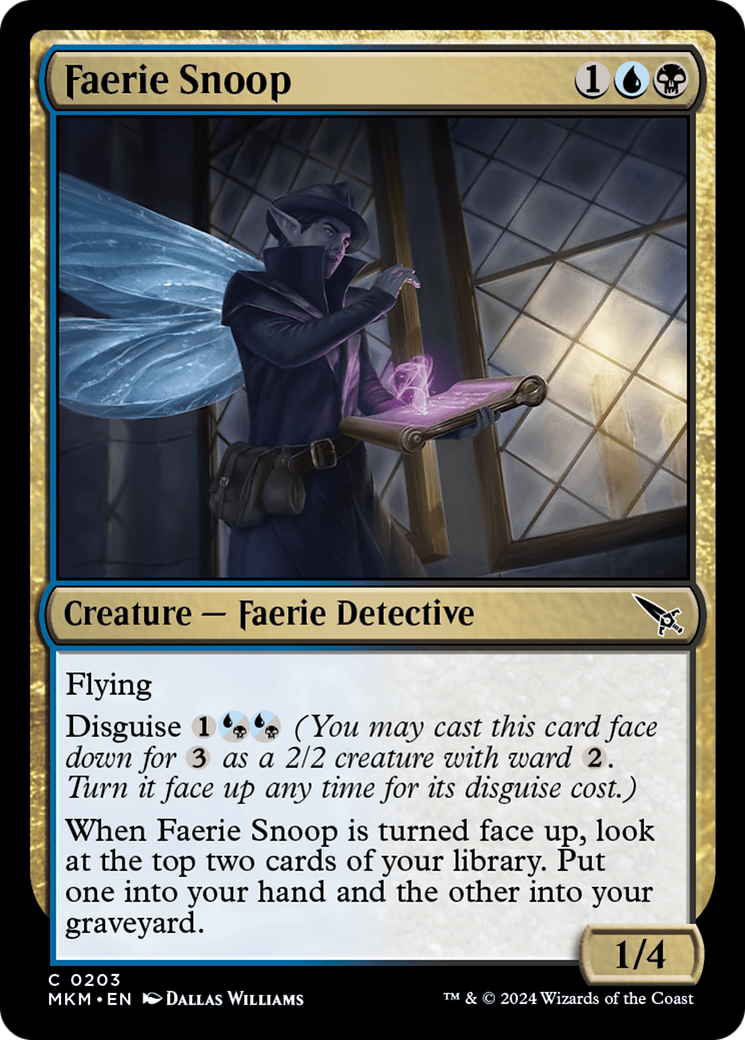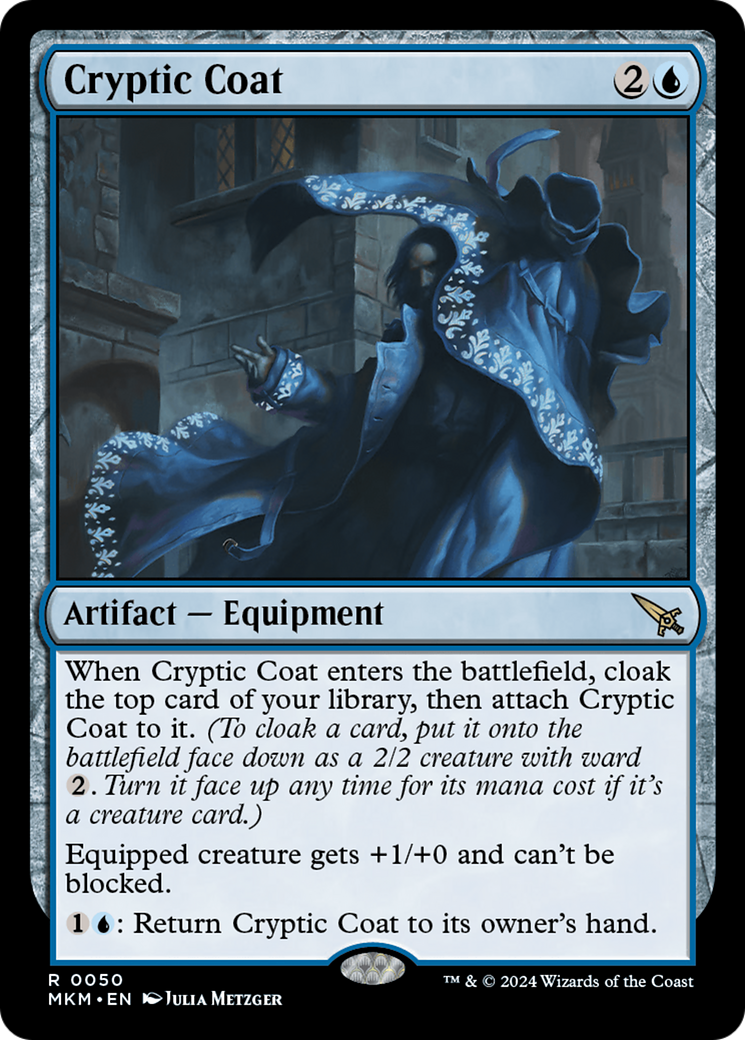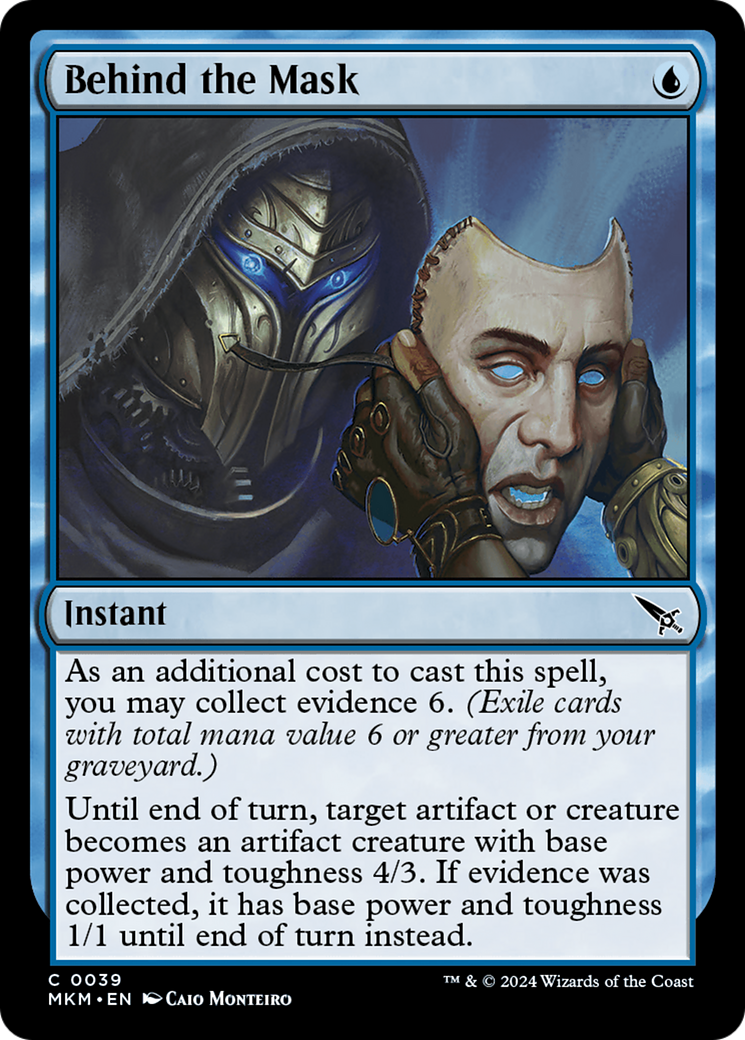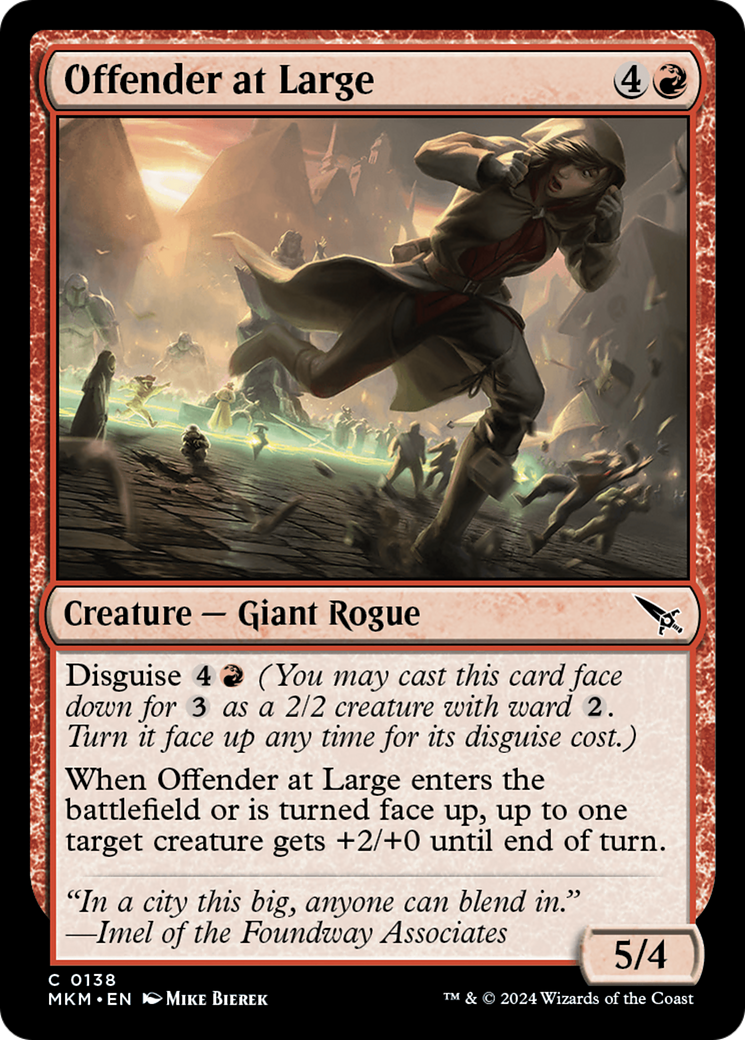Revealing the Intricacies of Disguise
02/02/2024
Disguise is one of the most interesting limited mechanics we've had in a while. It's a mechanic that provides a lot of choice, and naturally promotes a play pattern of more bluffing and calling bluffs.
This isn't the first time we've seen a mechanic like this - disguise as a mechanic works almost identically to the morph mechanic from Khans of Tarkir. But of course, limited has changed quite a bit since Khans, and the mechanic has changed to match - ward 2 is no joke! Plus, I wasn't playing back during Khans, and I never really felt like learning the format when it came back on Arena either.
What I have done is drafted and played the set quite a bit already, as part of Pro Tour testing (5 times, to be exact, including playing games each time). So today, off the back of those experiences, I'm going to analyze the disguise mechanic on its own merits, and talk all about how I expect the mechanic to play.
Part 1: The Mechanic Itself
For those who haven't played with morph before - and as a refresher for those who have - here's some details about how exactly it works this time with disguise:
Any creature with "disguise [mana cost]" may be cast as a face-down colorless 2/2 with ward 2 and no name for 3 generic mana. Then, disguise is a keyword that lets you pay the disguise cost to flip the face-down creature it's on face-up as a special action.
Notably, this is a special action - it doesn't use the stack, and so no one can respond to it. Once you pay the cost, it just happens; the creature is now face-up, and has all the characteristics it usually would (power, toughness, rules text, color, mana, name, etc).
However, flipping a disguise face-up can put triggered abilities on the satck. For example, cards like
Dog Walker - flipping it face-up causes it to immediately be a 3/1 with vigilance without needing a trigger, but puts the trigger to make two tapped 1/1 dogs onto the stack. You can respond to that.You do have to be careful though - a couple of the disguise creatures (
Bubble Smuggler and Crowd-Control Warden) use the wording "as this creature is turned face up", as opposed to "when this creature is turned face up". These abilities don't go on the stack, and just happen as a replacement effect immediately.So, it's important to keep in mind exactly what abilities do or don't go on the stack. Once your opponent decides to flip a 5/5 face-up, you no longer have a window to kill it with a
Shock. But on the flip side, your opponent can respond to you shocking their disguised creature by flipping it face-up to make it a 5/5, as Shock does use the stack.Part 2: Different Kinds of Disguise
While every disguise creature works the same way mechanically, they can also be grouped into two different kinds of disguise, based on how the play patterns work out.
Expensive, Large Disguises - and the 5 Mana Morph Rule

should've been an investi-gator
The first of these categories consists of large creatures that cost 5 or more mana to flip up. These largely stem from a rule that R&D made back in Khans of Tarkir - any morph that could directly eat a 2/2 (say, another morph) in combat when flipped face up must cost at least 5 mana to flip.
So, there is a whole category of disguises that cost 5 or more mana to flip face-up and are mostly just "big" on the front side. Some of them have abilities - like
Flourishing Bloom-Kin - but some of them are just stats and keywords.Overall, I count 10 disguises in this category at common, and 5 at uncommon - which represents a bit more than a third of all disguises in the set.
These disguise creatures are often overcosted, especially by today's standards. If they didn't have the ability to be disguised, you almost certainly wouldn't put them in your deck. A
5/5 for 6 mana that investigates when it connects is not particularly good, and neither is a 6/7 reach for 7 mana. But theoretically, the disguise can represent a lot of surprise value from bluffing.But more importantly - at least in my experience - the ability to play the disguise creature earlier than turn 6 or 7 is quite good. Just having another mode, even if it's not an amazing rate, helps mitigate some of the downside of clunky, expensive creatures.
This isn't to say that all of these disguise creatures are good.
Defenestrated Phantom, for example, is still quite unplayable. And I don't think any of the more vanilla creatures like Crocodelf or Hellion are premium or anything, just okay. But some of the disguise creatures that get value on flipping in addition to being big can be extremely strong - cards like Vengeful Creeper, Flourishing Bloom-Kin, and Greenbelt Radical.And of course, Gruul as an archetype this set somewhat focuses on large disguise creatures, with the help of
Tin Street Gossip. Having extra mana in order to be able to pay for all of these disguise costs quicker is a very important part of making the large, clunkier disguise creatures actually good.Cheap Value - ETBs in Disguise

it could be anything, even an Organ Hoarder
The second kind of disguise creatures in this set - which consists of a bit less than half of all disguises - are the cheap disguises that flip for usually 2-3 mana and give a small body but added value in other ways.
You can think of these kinds of disguises as kind of like enter-the-battlefield effects with extra steps - instead of just playing the creature and getting value, you pay in installments and have a 2/2 ward 2 in the meantime, plus a bit of surprise value.
Dog Walker can be thought of like a 3/1 that makes two 1/1s, that costs 3+2 mana.In fact, some of these effects are even just actual ETBs -
Gadget Technician, for instance, does the same thing whether you disguise it first or play it without disguising.In total, there are 8 at common, 5 at uncommon, and 6 at rare - notably, all the rare disguises somewhat fit into this category. Though to be fair, I might be stretching this definition somewhat by counting cards like
Nightdrinker Moroii, Hunted Bonebrute, and Sanguine Savior - the "value" to be gained for cards like these are more in the form tempo life swings.Overall, these cards have seemed pretty great! But that's mostly off the back of just having rates that are strong in a vacuum -
Dog Walker, Gadget Technician, and Nervous Gardener have been the exemplars of these at common in my experience. 3+2 mana for a 3/1 and two 1/1s, 3+2 mana for a 3/2 and a flying 1/1, and 3+1 mana for a 2/2 and a basic land are all pretty solid.In addition to that, many of these cheap value disguises provide flexibility in opposite direction as the expensive disguises - instead of spending 5 mana on Dog Walker, you can just play a 2 mana 3/1 vigilance for a very serviceable 2 drop.
And it makes sense that the way to evaluate this kind of disguises is mostly off the back of their raw rate - the surprise value doesn't matter nearly as much as for the expensive disguises, as these will all trade with a 2/2 anyways.
The Weird Ones - Noncreature Disguises
Two cards I'm not really including here in my analysis are
Branch of Vitu-Ghazi and Concealed Weapon. I don't think either is particularly good - colorless lands tend to be very costly, and overcosted equiment is not amazing either - but I haven't had much experience with either, and both are quite different than the rest of the disguises, so I'm not going to say much more than that.Part 3: Cloaked Combat

ironic that this card doesn't get into combat
The reason I've separated the disguises into two categories here is because the play patterns for the two categories are quite different - and so it's often very important to consider what kind of disguise your opponent is representing.
One of the biggest gameplay questions in this format will be: what will you do when your opponent attacks their disguise into your 2/2, with mana available to flip the disguise?
The first, most basic thing to consider is the 5 mana rule: do they have 5 mana? If not, they at least can't eat your 2/2 by just flipping their disguise. Of course, this doesn't mean it'll necessarily be a good trade - your opponent could flip a
Museum Nightwatch to punish you for trading.But what if they do have 5 mana? What do you do then?
Have a Plan
The biggest thing is to have a plan for what you do if your opponent does have a big morph. Sometimes it can be okay to walk right into a trap! But to know whether you should, you need to be aware of the possible risks.
Consider: what happens if you take the damage? Maybe you're even just happier to chump! If you're at 7 or lower, not blocking a morph against a red deck could lead to death by way of
Offender at Large. Against a blue or green deck, maybe you suspect that their disguise is an Undercover Crocodelf, and you'd rather chump than give them a clue. And of course, forcing them to have it is a classic refrain when it comes to combat tricks - there's plenty of value to be had in forcing your opponent to act and tie up their mana.You can also plan ahead to have a way to deal with most of the ways they could punish you - having
instant speed interaction available can result in a blowout in the other direction. You also don't necessarily need to have interaction immediately in the moment - sometimes it's just good to let your opponent spend a lot of mana to eat your expendable creature, while you get to untap and cast an efficient removal spell and get ahead. Sometimes you might decline to block one turn, with the plan of blocking the following turn when you're better positioned to.It's also important to keep in mind what happens if the opponent chooses not to flip their disguise, or if they do and it's a value creature that trades but leaves something behind! Maybe the trade is actually bad for you - maybe you need to keep your disguise on the battlefield so you can keep up in the value game.
You should also be thinking about what all the possible disguises your opponent could have are - there's only 36 in the set, which is a sizable but finite number! Of course this will come with experience, but even just knowing your opponent's colors can narrow it down to only roughly a third of the possibilities. And in a best-of-three match, you should be paying attention to what disguises your opponent played in previous games to keep in mind for the future.
In the end, the most important thing is to just have a plan. Be cognizant of what your opponent can do with disguise, and consider how different lines can affect your plan.
Part 4: Removing the Mask

this card has nothing to do with disguise, but I couldn't resist the pun
The only difference between disguise and morph is that disguised creatures have ward 2. And at first glance, you might think that difference isn't that big - do you really care about removing your opponent's 3 mana 2/2? But the answer is yes, you in fact would care quite a bit, and the ward is a very necessary measure to prevent that and make disguise playable.
The main sticking point is that letting your opponent flip a disguise naturally represents some amount of value - either they're getting to improve their creature substantially (big expensive disguises), or they're getting value in some way (small value disguises), or sometimes both. Plus, the big disguises even can represent some threat of getting a "free" combat trick - removing the disguise while they're tapped out would avoid all of that headache.
But unfortunately, ward 2 means there generally won't be a way to remove a disguised creature without spending at least 3 mana - so you won't ever trade up on mana, which knocks out one of the most powerful ways you can leverage removal.
However, it may still often be correct to just bite the bullet and do so, especially if you're getting an even trade with something like Shock! Unlike true enter-the-battlefield value effects, value disguise creatures can still be traded with in a clean 1-for-1 exchange - but only as long as they can't be flipped face up. So you'll often find yourself incentivized to just trade with a disguise your opponent plays on turn 3 immediately. After all, the difference between your red white opponent having two extra dogs from Dog Walker or just trading a creature 1-for-1 is quite massive.
As a sidenote, you do need to be careful with enchantment removal like
Makeshift Binding - if you remove a large disguise creature while it's face-down, and then your opponent removes the Binding, then you've given them a massive mana advantage, as their big disguise creature comes back into play face-up.Part 5: Disguise and Damage

I've been pleasantly surprised by this one - the offensive capabilities have not offended
One prediction I've heard thrown around a lot is that games will be a bit slower this set, as the creature sizing is smaller - and it certainly is true that the creature sizing is smaller, presumably in order to make 3 mana 2/2 disguises interact better in combat.
But after playing the set, I don't think this is completely true. Specifically, while the creature sizing is smaller, and while that would theoretically suggest that you take damage slower, the fact that disguises represent a bunch of combat trickery means that creatures will go unblocked more often than usual.
For instance, I've had quite a few games where an unblocked
Offender at Large or other large disguise meant someone was suddenly taking 4-5 more damage than expected. If it had just been a normal face-up 5/4, perhaps it would've been double-blocked, but you're almost never going to do that in the blind against a face-down disguise.Plus, disguise inherently incentivizes players to play face-down 2/2s and then not block with them, as they want to them flip those disguises face-up. And if you don't block with your 2/2, then you're more incentivized to attack with them the following turn.
You could even think of this as a kind of pseudo-haste effect, or like suspend. With a normal creature, the first chance you have to have it engage in combat is blocking with it the turn you play it. But with disguises, the first chance you have of engaging in combat with something that isn't just the face-down 2/2 will often be attacking with it the next turn.
All of this is to say, you should really still pay quite a lot of attention to your curve in this set. I don't think it's going to be much "faster" or "slower" than normal, for certain definitions of those words. There are fewer cheap creatures than we usually see, but they're just as important - which, in a sense, makes them even more of a priority in draft due to scarcity.
Conclusion
It'll be interesting to see how disguise plays out as the format develops. These have just been my initial thoughts on the mechanic, after less than a week of playing the format - I expect them to give a fairly good impression, but with some inaccuracies from low sample size. Maybe the set turns out to actually be glacially slow.
But still, this is probably a lot more than most have played the format as I'm writing this - just ahead of prerelease tomorrow! So hopefully this analysis is at least timely, if nothing else.
#FreePalestine | Consider donating to UNWRA or PCRF, supporting protesters locally, and educating yourself.
